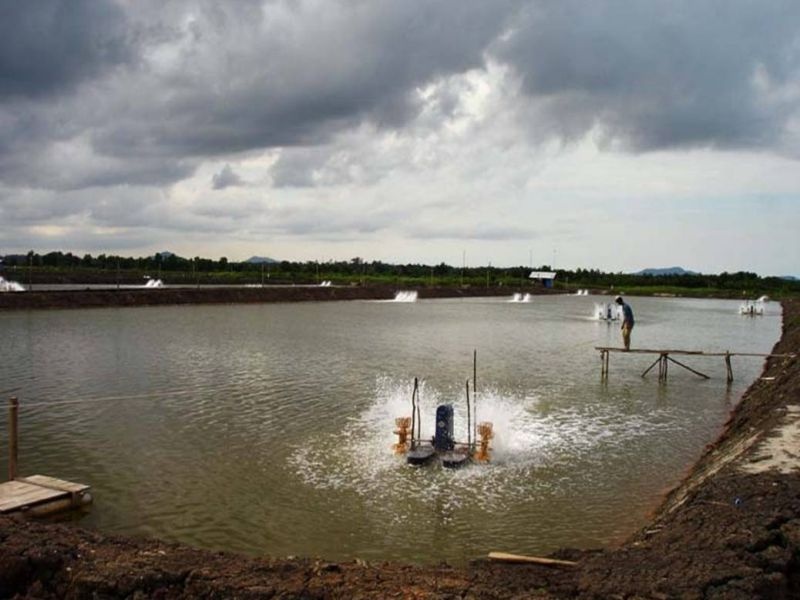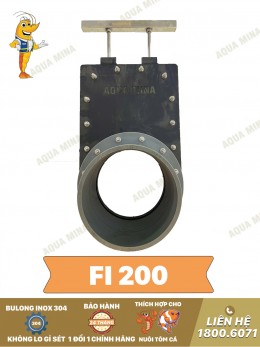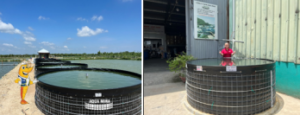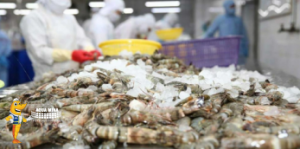Steps to Protect Shrimp Ponds Before Storms and Floods

Storms can cause fluctuations in the pond environment, impacting shrimp health.
During the storm season, heavy, prolonged rains often alter the water's physical, chemical, and biological factors in a negative way. These changes weaken shrimp’s resistance, making them more susceptible to pathogens like bacteria, viruses, and parasites, which can lead to disease outbreaks and reduced farming efficiency.
To protect and enhance shrimp farming efficiency while minimizing storm-related losses, shrimp farmers should apply the following measures:
Enhance the Drainage System
One crucial step is ensuring the pond’s drainage system operates efficiently. Before the storm season, farmers should check the overflow outlets and prepare clean water sources for replacing pond water when needed.
Salinity levels in pond water fluctuate drastically during storms. To avoid sudden drops in salinity, farmers must plan water regulation. Before heavy rain, they should fill the pond with appropriately saline water to keep water levels high.
During the rain, it’s important to avoid activities that stir up the pond water. After rain, quickly drain some surface water by opening the drainage gates. In acidic soil areas, farmers should spread lime around the pond banks before rain to prevent acidic water from flowing into the pond and altering the pH.
Moreover, farmers should regularly monitor weather forecasts to take timely measures like harvesting market-sized shrimp before storms hit.
Reinforce Pond Banks
Pond banks are critical for retaining water and keeping shrimp inside. The pond banks should be raised at least 0.4–0.5m above the rainwater level when storms approach. To avoid damage, shrimp farmers need to inspect and reinforce embankments, repair watchtowers, and strengthen auxiliary structures. If banks are not reinforced, farmers should use nets with appropriate mesh size around the pond to prevent shrimp from escaping.

For ponds near the coast, plant windbreaks or sand barriers and prepare sandbags to protect embankments. Cover shrimp farming equipment securely and tie it down carefully.
For ponds not yet stocked with shrimp, strengthen pond banks, aeration systems, and aerators to be ready for stocking after the storm.
Disease Prevention Measures
During the storm season, environmental parameters will fluctuate greatly, weakening shrimp and reducing their resistance. Therefore, farmers should take preventive measures by regularly supplementing shrimp feed with vitamin C, trace minerals, and probiotics every 10-15 days for 5-7 days at a time.
Monitor shrimp activity and water quality before and after rain to respond promptly.
If shrimp show signs of stress (e.g., surfacing), identify the cause—if due to low oxygen, increase aeration, spray water, reduce feed, replace part of the water, or add fresh water. Spacing out the shrimp can also reduce stocking density.
Increase aeration time to avoid oxygen depletion and prevent water stratification. Have a generator and aerators ready in case of power outages.
Provide Sufficient Feed and Care
Before the storm season, prepare feed reserves and develop a proper care plan. In case of flooding or storm damage, providing enough feed and proper care will help minimize stress and loss in the shrimp population.

Add probiotics and minerals to the feed to boost shrimp resistance to unusual weather conditions.
During storms, when temperatures drop, shrimp will reduce their feeding activity, so farmers should adjust feed amounts to avoid excess that could pollute the pond and create toxic gases in the water. If the pond temperature drops to 18-22°C, reduce the feed amount by 20-30% compared to normal levels.
Build an Early Warning and Monitoring System
Establishing a weather alert and continuous monitoring system is essential. Farmers should use technology to monitor weather conditions and the pond environment. Early warning systems help detect weather changes in time and implement appropriate responses.
Finally, shrimp farmers should regularly follow floodwater level updates on rivers and storm conditions through mass media to implement effective pond protection measures.
Storms can cause serious damage to shrimp ponds, but with preventive and responsive measures, losses can be minimized. Thorough preparation, from reinforcing pond banks to using monitoring technology, will help protect assets and reduce shrimp loss.
Source: nguoinuoitom
Ngày đăng : 14/09/2024
2174 View
Other Articles
Vietnamese shrimp and catfish choose a sustainable path in global competition
End-of-Season Shrimp Prices Reach Record Highs
Norway – Russia Reach Barents Sea Fisheries Agreement for 2026
Cà Mau strengthens traceability to enhance the competitiveness of the shrimp industry.
Cold stress: Effects on the plasma characteristics of whiteleg shrimp.
A new breakthrough in the prevention of diseases caused by the microsporidian parasite EHP in shrimp farming
Vietnam’s shrimp export outlook in the first quarter of 2026 continues to face heavy pressure from tariffs.
New England’s shrimp fishery to shut down for the long haul after years of decline
Crab exports to the United States account for more than 80%.
Thailand sets a target to increase shrimp production to 400,000 tons by 2026.
CTU-RAS: Recirculating Shrimp Farming for Sustainable Development
Vietnamese aquatic products reach new markets



















.jpg)